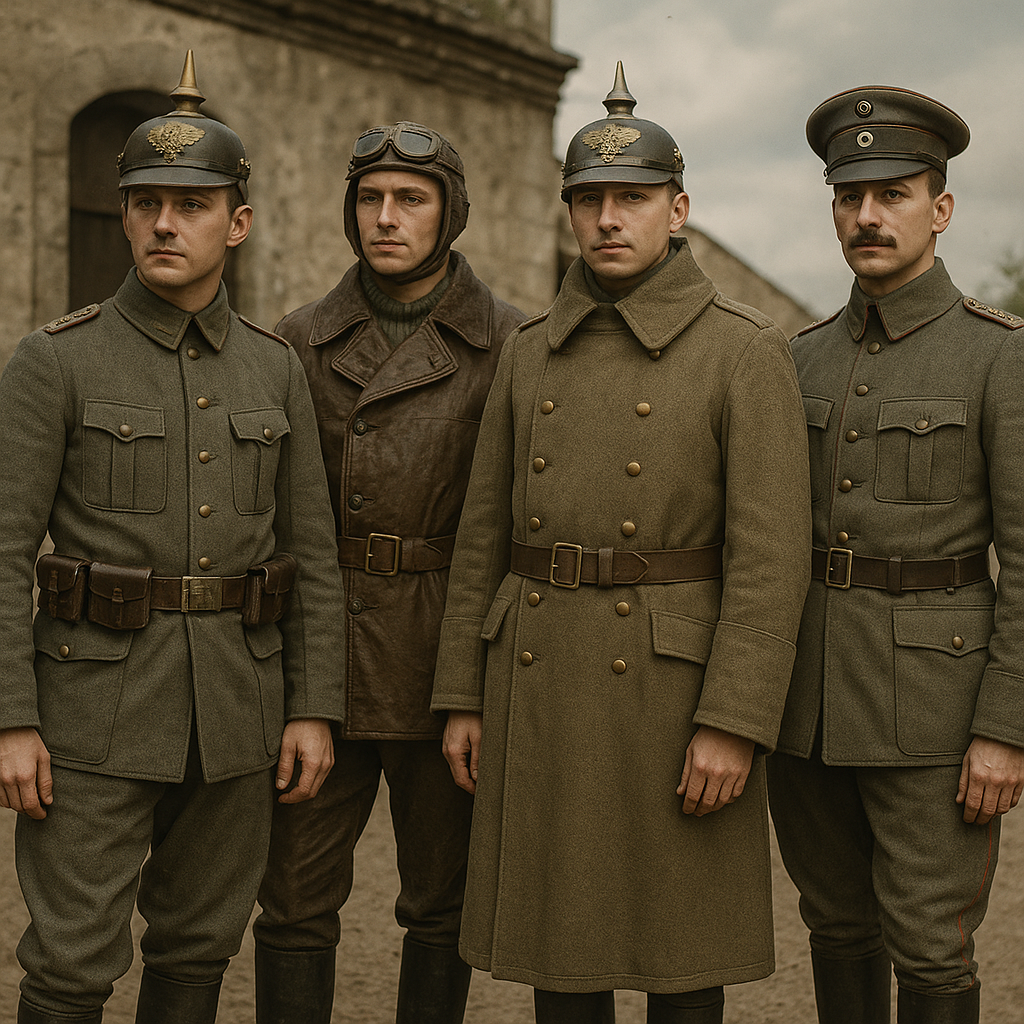
WW1 German Uniforms: Iconic Styles, Coats, and Jackets from the Great War
Published on Jun 15, 2025
WW1 German Uniforms: A Timeless Symbol of History and Craftsmanship
When we think of World War I, images of trench warfare, cavalry charges, and the first use of mechanized warfare come to mind. But one of the most enduring symbols of the Great War is the WW1 German uniform — a blend of functionality, symbolism, and military pride.
Whether you're a collector, historian, or simply someone fascinated by military fashion, understanding the intricacies of WWI German jackets, coats, and flying gear opens a portal into the daily lives of soldiers who fought in one of the most defining conflicts in history.
The Anatomy of the WW1 German Uniform
The German army entered World War I with one of the most recognizable and structured military uniforms. Early on, the uniforms were crafted with both aesthetics and practicality in mind. Here's what defined them:
1. The Standard WW1 German Uniform
- Colour and Fabric: Early uniforms were made of wool in a field-grey tone known as "Feldgrau." This shade offered effective camouflage and replaced the Prussian blue of earlier times.
- Tunic (Blue): The iconic German tunic had a standing collar, pleated breast pockets, and red piping that denoted different branches of service.
- Shoulder Straps and Rank Insignia: Shoulder boards indicate regiment, rank, and unit. Officers often added subtle embellishments.
- WW1 German Jacket: The jacket worn by enlisted men and officers varied slightly in cut and decoration but remained function-focused.
WW1 German Coats: Surviving the Trench Winters
The war was notoriously brutal during the winters, especially in the trenches of the Western Front. The WW1 German coat, or Mantel, was designed to endure harsh conditions:
- Double-Breasted Design: Provided extra warmth and layered protection.
- Wool Construction: Thick and heavy wool helps retain body heat.
- Collars and Cuffs: Often featured contrasting colours or linings, with officers allowed some personalization.
- Greatcoats and Capes: Some specialized units, like Uhlans or cavalry officers, had longer coats with dramatic flair.
Collectors today value original WW1 German coats for their craftsmanship and unique wear patterns, which tell personal stories of the war.
World War 1 Pilot Uniform: The Sky Warriors' Gear
As aerial combat emerged during WWI, uniforms had to adapt to a new set of challenges. The World War 1 pilot uniform reflected the need for warmth, mobility, and identity in high-altitude conditions.
Key Features:
- Flight Suits: Typically one-piece or two-piece leather suits, wind-resistant and insulated.
- WW1 Flying Jacket: Pilots wore thick leather jackets lined with sheepskin or wool. These jackets became legendary and influenced civilian fashion long after the war.
- Headgear and Goggles: Protection against cold winds and debris was crucial. Flight helmets and aviation goggles were standard gear.
- Scarves and Gloves: Pilots often wore silk scarves to prevent neck chafing during head movement in the cockpit.
German flying aces like Manfred von Richthofen — better known as the Red Baron — became iconic figures, and their uniforms remain some of the most sought-after by military fashion enthusiasts.
Naval Forces: The WWI US Navy Uniform vs. German Counterparts
While this article primarily explores WW1 German uniforms, it's worth noting the differences between German and American naval wear during the same period.
- WWI US Navy Uniform: Recognized by its dark blue wool, the American naval uniform included bell-bottom trousers, sailor collars, and brass buttons. It was ceremonial yet rugged for duty.
- German Navy Uniforms (Kaiserliche Marine): Similar in build, the German version featured detailed insignia, heavy coats, and ship-specific variations.
For collectors, both styles offer distinct aesthetics and historical value, but the German versions are often harder to find in pristine condition.
Why WW1 Uniforms Still Fascinate Today
Military history buffs, reenactors, filmmakers, and collectors all seek out authentic WW1 German jackets, coats, and pilot gear for several reasons:
- Historical Authenticity: Museums and educational institutions use these uniforms to bring history to life.
- Fashion Influence: WWI flying jackets directly influenced bomber jackets and aviation-inspired fashion that remains popular today.
- Personal Connection: Many descendants of veterans collect pieces to honour family history.
At Paddelaters.com, we're proud to offer historically accurate reproductions and rare original pieces that capture the spirit of the era. From the elite Air Force pilot's gear to the trench-worn soldier's coat, each item has a story to tell.
How to Identify Authentic WW1 German Uniform Pieces
If you're shopping for WW1 German uniform pieces, consider the following tips:
- Check the Stitching and Fabric: Originals; use natural fibres like wool, leather, and cotton with hand or early-machine stitching.
- Insignia and Markings: Look for unit numbers, dates, and maker's stamps inside the jackets or coats.
- Patina and Wear: Age and wear patterns can confirm authenticity, but beware of artificially aged replicas.
- Documentation: Provenance can add immense value. Receipts, photographs, or service records are often included with rare finds.
Final Thoughts: Preserving the Legacy of WW1 Uniforms
The First World War reshaped the 20th century, and the uniforms worn during this time are more than just fabric and buttons — they are fragments of history. From the stoic German infantryman in his wool coat to the daring pilot in his WW1 flying jacket, each uniform represents courage, innovation, and sacrifice.
Whether you're building a collection, researching for a project, or simply admiring the aesthetics, exploring WWI German uniforms is a fascinating journey through the past.
